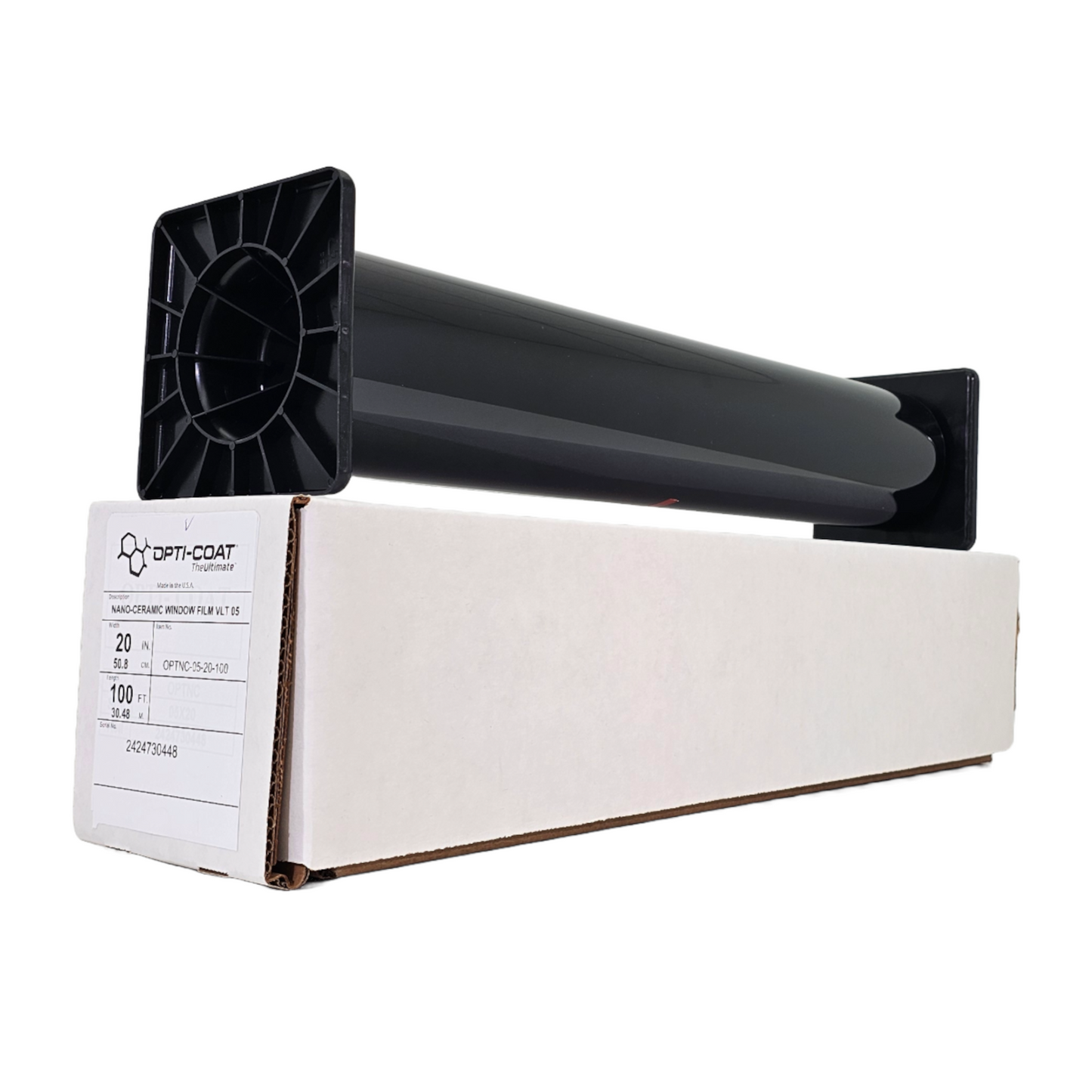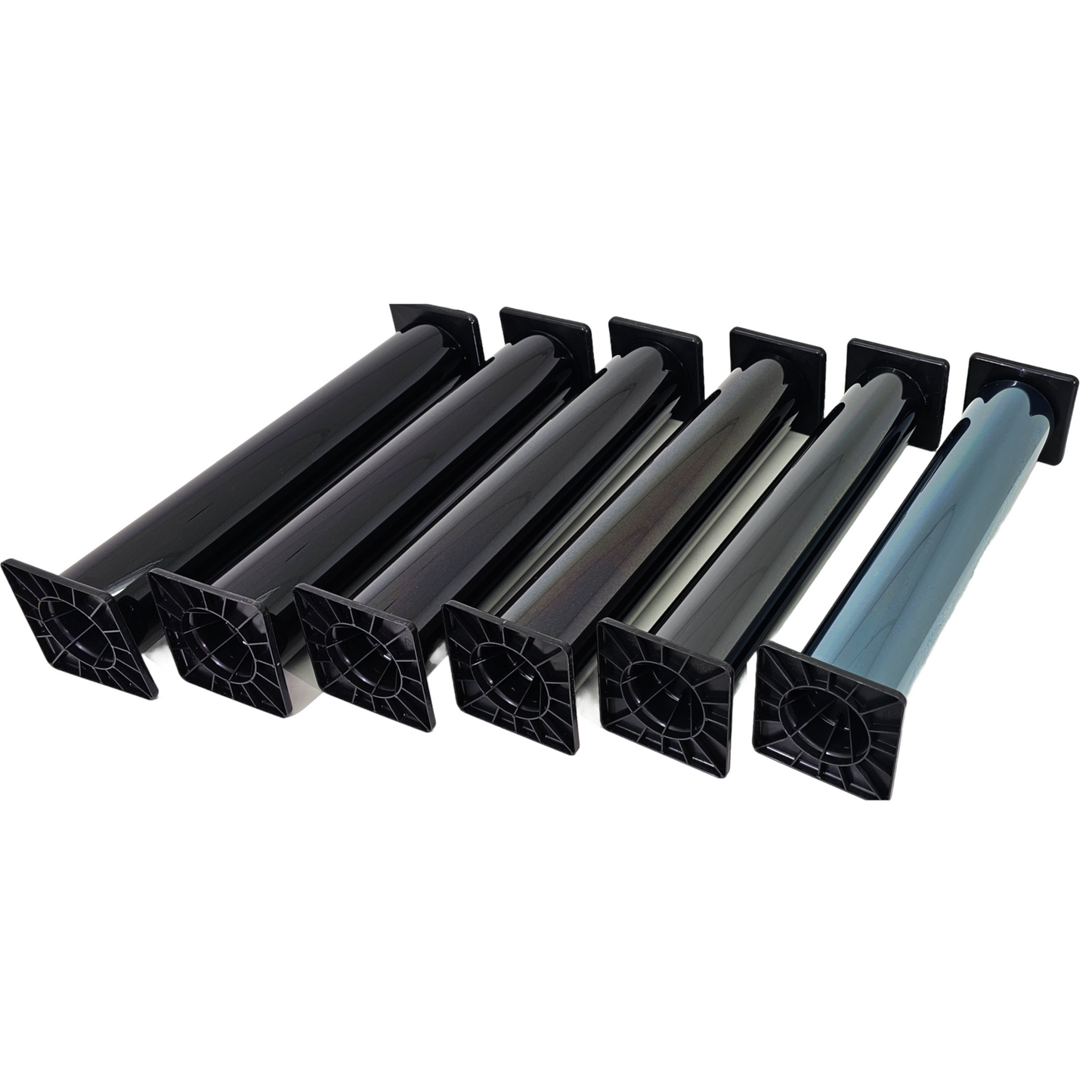Opti-Coat
Opti-Coat Nano-Ceramic Window Tint
Opti-Coat Nano-Ceramic Window Tint
FREE Shipping Over $49
Couldn't load pickup availability
Opti-Coat Nano-Ceramic Window Tint
Made in USA
Opti-Coat's new Nano-Ceramic Window Tint features high heat rejection, premium adhesives and a deep black color. Our window films are rated in accordance with National Fenestration Rating Council (NFRC) standards and calculated on single pane 6mm (1/4”) clear glass. IR Rejection is tested in the full IR range of 780 to 2500 nanometers, not selected areas of the spectrum.
High IR heat rejection film is available in VLT shades 5%, 20%, 35%, 45%, 55% and 75%.
All rolls are 100 feet long. Available sizes are 20", 24", 36", 40" and 60".
Key Features
- High infrared heat rejection with nano-ceramic technology
- Metal-free construction, won't interfere with wireless or satellite signals
- Color stable Ceramic film will not turn purple
- Rich Black color with no brown, green, gray or blue hues
- Lifetime No-Fade Warranty
Performance Data
Opti-Coat Nano Ceramic 5
Visible Light Transmitted 4% Reflected 5% Glare Reduction 95% Total Solar Energy Transmitted 9% Reflected 5% Absorbed 85% Shading Coefficient 0.42 Solar Heat Gain Coefficient 0.37 "U" Factor 1.02 Ultraviolet Light Rejected 99% Total Solar Energy Rejected 63% Infrared Rejection 87% Infrared Energy Rejected 60%
Opti-Coat Nano Ceramic 20
Visible Light Transmitted 21% Reflected 6% Glare Reduction 76% Total Solar Energy Transmitted 18% Reflected 5% Absorbed 77% Shading Coefficient 0.49 Solar Heat Gain Coefficient 0.43 "U" Factor 1.02 Ultraviolet Light Rejected 99% Total Solar Energy Rejected 57% Infrared Rejection 87% Infrared Energy Rejected 60%
Opti-Coat Nano Ceramic 35
Visible Light Transmitted 38% Reflected 6% Glare Reduction 57% Total Solar Energy Transmitted 23% Reflected 5% Absorbed 72% Shading Coefficient 0.53 Solar Heat Gain Coefficient 0.46 "U" Factor 1.02 Ultraviolet Light Rejected 99% Total Solar Energy Rejected 54% Infrared Rejection 87% Infrared Energy Rejected 60%
Opti-Coat Nano Ceramic 45
Visible Light Transmitted 43% Reflected 6% Glare Reduction 52% Total Solar Energy Transmitted 24% Reflected 5% Absorbed 70% Shading Coefficient 0.54 Solar Heat Gain Coefficient 0.47 "U" Factor 1.02 Ultraviolet Light Rejected 99% Total Solar Energy Rejected 53% Infrared Rejection 87% Infrared Energy Rejected 60%
Opti-Coat Nano Ceramic 55
Visible Light Transmitted 52% Reflected 7% Glare Reduction 41% Total Solar Energy Transmitted 29% Reflected 6% Absorbed 65% Shading Coefficient 0.57 Solar Heat Gain Coefficient 0.50 "U" Factor 1.02 Ultraviolet Light Rejected 99% Total Solar Energy Rejected 50% Infrared Rejection 87% Infrared Energy Rejected 60%
Opti-Coat Nano Ceramic 75
Visible Light Transmitted 72% Reflected 8% Glare Reduction 19% Total Solar Energy Transmitted 35% Reflected 6% Absorbed 59% Shading Coefficient 0.61 Solar Heat Gain Coefficient 0.53 "U" Factor 1.02 Ultraviolet Light Rejected 99% Total Solar Energy Rejected 47% Infrared Rejection 87% Infrared Energy Rejected 60%
Window Film Terminology
Visible Light
The portion of the solar spectrum containing visible light we can see, from roughly 380nm up to 780nm, contains all the colors of the spectrum.
- Transmitted: the amount of visible light that passes through the glass, into the building. This is how light or dark the film is.
- Reflected Exterior: the amount of visible light that is reflected off the exterior surface of the window. This is seen when standing outside the building. A higher reflectance value means the window looks more like a mirror from the outside.
- Reflected Interior: the amount of visible light that is reflected off the interior surface of the window. This is seen when standing inside the building looking out. A higher reflectance value means the window looks more like a mirror from the inside.
- Glare Reduction: the reduction in visible light transmitted compared to clear unfilmed glass.
Total Solar Energy
All the energy in the solar spectrum that reaches us on the earth’s surface. This includes UVA and UVB, Visible light, and Infrared energy up to roughly 2500nm.
- Transmitted: the amount of total solar energy that passes through the glass, into the building.
- Reflected: the amount of total solar energy that is reflected off of the glass and directed back outside. This energy does not come into the building.
- Absorbed: the amount of total solar energy that is absorbed into the glass. This heats up the glass, making it hotter to the touch, and re-radiates a small amount of heat back into the room. The majority of absorbed energy is kept out of the room though.
Shading Coefficient
The ratio of heat passing through a filmed window to heat passing through clear unfilmed glass. A lower number means better heat rejection.
Solar Heat Gain Coefficient
Similar to the shading coefficient, except this value also takes into account energy that is re-radiated back into the room from the glass heating up due to increased absorption. Again, a lower number means better heat rejection.
U Factor
Heat transfer due to temperature differences outside and inside. Represents the amount of heat passing through 1 sq ft of glass in 1 hour for every 1 degree temperature difference between the outside and inside. A lower value means less heat passes through, and this is generally of interest for keeping heat inside the building in cold climates.
Ultraviolet Light Rejection
The amount of UV energy blocked by the film, either by reflecting or absorbing it. This energy does not enter the building.
Emissivity
The ability of the surface to reflect infrared energy. For window film, this means how much heat it will re-radiate back into a room. Low E glass and films have low emissivities, which means they reflect a lot of heat back into the room, which is the desired effect in cold climates.
Light-to-Solar-Gain Ratio (LSG)
Provides a gauge of the relative efficiency of different film types in transmitting daylight while blocking heat gains. It is determined by the ratio between visible light transmittance and the solar heat gain coefficient. The higher the number, the more light transmitted without adding excessive amounts of heat.
Total Solar Energy Rejection
The total amount of solar energy that is kept out of the building. Although not accurate, this is commonly referred to as heat rejection.
Infrared Rejection
The amount of infrared (IR) energy that is blocked by the film, either by reflecting or absorbing. This value is for the whole IR region of the solar spectrum, roughly 780nm up to 2500nm.
Infrared Energy Rejection (IRER)
Is a measurement of infrared rejection over the IR range of 780-2500 nm. IRER takes into account that a portion of absorbed IR energy will be
re-radiated into a car or building. Similar to Total Solar Energy Rejection, but only involves the solar infrared range.
Tensile Strength
The value of a 1” x 1” square of film being pulled apart in the same manner as the film break strength test. It is generally calculated up from the break strength and reported in pounds per square inch, (PSI).
Break Strength
The actual load or force at which fracture occurs measured in pounds per inch (width). Break strength is a function of tensile strength.
Peel Strength
The force necessary to remove a coated material adhered to a prescribed surface from that surface measured in pounds per inch width.
Share




